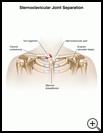
Sternoclavicular Joint Separation
________________________________________________________________________
KEY POINTS
- A sternoclavicular joint separation is when your collarbone separates from your breastbone.
- You will need to change or stop doing the activities that cause pain until the ligament has healed. You may need surgery.
________________________________________________________________________
What is a sternoclavicular joint separation?
The sternoclavicular joint is located in the center of your upper chest where your collarbone attaches to your breastbone. These bones are connected by a strong band of tissue called a ligament. If the ligament tears, your collarbone can separate from your breastbone.
What is the cause?
A sternoclavicular joint separation is usually caused by a direct hit to your breastbone or collarbone. It may also be caused by a fall onto your shoulder or onto your outstretched hands that puts pressure on your collarbone.
What are the symptoms?
Symptoms may include:
- Swelling
- Pain
- Your collarbone may be in front of or behind your breastbone. The broken end may stick up or be pushed in.
How is it diagnosed?
Your healthcare provider will ask about your symptoms and medical history and examine you. Tests may include:
- X-rays
- CT scan, which uses X-rays and a computer to show detailed pictures of the chest
- MRI, which uses a strong magnetic field and radio waves to show detailed pictures of the chest
- Arteriogram, also called an angiogram, which is a series of X-rays taken after your healthcare provider injects a special dye into your blood vessels to look for damage
How is it treated?
You will need to change or stop doing the activities that cause pain until the ligament has healed. You may need surgery if:
- The end of the collarbone is forced behind the breastbone where it could damage your heart or the blood vessels in your chest.
- The joint heals but is unstable and causes pain.
How can I take care of myself?
Follow the full course of treatment prescribed by your healthcare provider. In addition:
- Put an ice pack, gel pack, or package of frozen vegetables wrapped in a cloth on the injured area every 3 to 4 hours for up to 20 minutes at a time.
- Take nonprescription pain medicine, such as acetaminophen, ibuprofen, or naproxen. Read the label and take as directed. Unless recommended by your healthcare provider, you should not take these medicines for more than 10 days.
- Nonsteroidal anti-inflammatory medicines (NSAIDs), such as ibuprofen, naproxen, and aspirin, may cause stomach bleeding and other problems. These risks increase with age.
- Acetaminophen may cause liver damage or other problems. Unless recommended by your provider, don't take more than 3000 milligrams (mg) in 24 hours. To make sure you don’t take too much, check other medicines you take to see if they also contain acetaminophen. Ask your provider if you need to avoid drinking alcohol while taking this medicine.
- Wear a sling as directed by your healthcare provider.
- Rest your shoulder and arm on the side of the separation until the pain goes away.
Ask your provider:
- How and when you will get your test results
- How long it will take to recover
- If there are activities you should avoid and when you can return to your normal activities
- How to take care of yourself at home
- What symptoms or problems you should watch for and what to do if you have them
Make sure you know when you should come back for a checkup. Keep all appointments for provider visits or tests.

